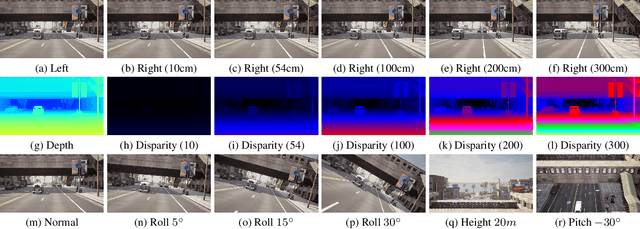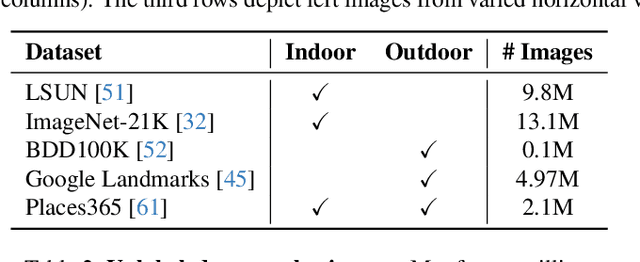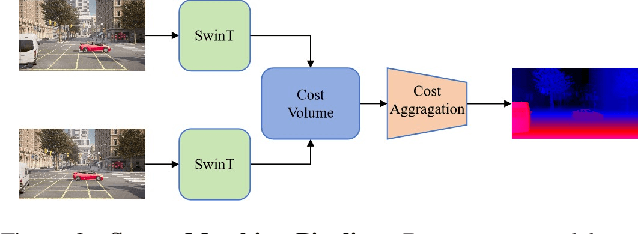Xianda Guo
InsightDrive: Insight Scene Representation for End-to-End Autonomous Driving
Mar 17, 2025Abstract:Directly generating planning results from raw sensors has become increasingly prevalent due to its adaptability and robustness in complex scenarios. Scene representation, as a key module in the pipeline, has traditionally relied on conventional perception, which focus on the global scene. However, in driving scenarios, human drivers typically focus only on regions that directly impact driving, which often coincide with those required for end-to-end autonomous driving. In this paper, a novel end-to-end autonomous driving method called InsightDrive is proposed, which organizes perception by language-guided scene representation. We introduce an instance-centric scene tokenizer that transforms the surrounding environment into map- and object-aware instance tokens. Scene attention language descriptions, which highlight key regions and obstacles affecting the ego vehicle's movement, are generated by a vision-language model that leverages the cognitive reasoning capabilities of foundation models. We then align scene descriptions with visual features using the vision-language model, guiding visual attention through these descriptions to give effectively scene representation. Furthermore, we employ self-attention and cross-attention mechanisms to model the ego-agents and ego-map relationships to comprehensively build the topological relationships of the scene. Finally, based on scene understanding, we jointly perform motion prediction and planning. Extensive experiments on the widely used nuScenes benchmark demonstrate that the proposed InsightDrive achieves state-of-the-art performance in end-to-end autonomous driving. The code is available at https://github.com/songruiqi/InsightDrive
Bidirectional Prototype-Reward co-Evolution for Test-Time Adaptation of Vision-Language Models
Mar 12, 2025Abstract:Test-time adaptation (TTA) is crucial in maintaining Vision-Language Models (VLMs) performance when facing real-world distribution shifts, particularly when the source data or target labels are inaccessible. Existing TTA methods rely on CLIP's output probability distribution for feature evaluation, which can introduce biases under domain shifts. This misalignment may cause features to be misclassified due to text priors or incorrect textual associations. To address these limitations, we propose Bidirectional Prototype-Reward co-Evolution (BPRE), a novel TTA framework for VLMs that integrates feature quality assessment with prototype evolution through a synergistic feedback loop. BPRE first employs a Multi-Dimensional Quality-Aware Reward Module to evaluate feature quality and guide prototype refinement precisely. The continuous refinement of prototype quality through Prototype-Reward Interactive Evolution will subsequently enhance the computation of more robust Multi-Dimensional Quality-Aware Reward Scores. Through the bidirectional interaction, the precision of rewards and the evolution of prototypes mutually reinforce each other, forming a self-evolving cycle. Extensive experiments are conducted across 15 diverse recognition datasets encompassing natural distribution shifts and cross-dataset generalization scenarios. Results demonstrate that BPRE consistently achieves superior average performance compared to state-of-the-art methods across different model architectures, such as ResNet-50 and ViT-B/16. By emphasizing comprehensive feature evaluation and bidirectional knowledge refinement, BPRE advances VLM generalization capabilities, offering a new perspective on TTA.
Keeping Yourself is Important in Downstream Tuning Multimodal Large Language Model
Mar 06, 2025Abstract:Multi-modal Large Language Models (MLLMs) integrate visual and linguistic reasoning to address complex tasks such as image captioning and visual question answering. While MLLMs demonstrate remarkable versatility, MLLMs appears limited performance on special applications. But tuning MLLMs for downstream tasks encounters two key challenges: Task-Expert Specialization, where distribution shifts between pre-training and target datasets constrain target performance, and Open-World Stabilization, where catastrophic forgetting erases the model general knowledge. In this work, we systematically review recent advancements in MLLM tuning methodologies, classifying them into three paradigms: (I) Selective Tuning, (II) Additive Tuning, and (III) Reparameterization Tuning. Furthermore, we benchmark these tuning strategies across popular MLLM architectures and diverse downstream tasks to establish standardized evaluation analysis and systematic tuning principles. Finally, we highlight several open challenges in this domain and propose future research directions. To facilitate ongoing progress in this rapidly evolving field, we provide a public repository that continuously tracks developments: https://github.com/WenkeHuang/Awesome-MLLM-Tuning.
WMNav: Integrating Vision-Language Models into World Models for Object Goal Navigation
Mar 04, 2025Abstract:Object Goal Navigation-requiring an agent to locate a specific object in an unseen environment-remains a core challenge in embodied AI. Although recent progress in Vision-Language Model (VLM)-based agents has demonstrated promising perception and decision-making abilities through prompting, none has yet established a fully modular world model design that reduces risky and costly interactions with the environment by predicting the future state of the world. We introduce WMNav, a novel World Model-based Navigation framework powered by Vision-Language Models (VLMs). It predicts possible outcomes of decisions and builds memories to provide feedback to the policy module. To retain the predicted state of the environment, WMNav proposes the online maintained Curiosity Value Map as part of the world model memory to provide dynamic configuration for navigation policy. By decomposing according to a human-like thinking process, WMNav effectively alleviates the impact of model hallucination by making decisions based on the feedback difference between the world model plan and observation. To further boost efficiency, we implement a two-stage action proposer strategy: broad exploration followed by precise localization. Extensive evaluation on HM3D and MP3D validates WMNav surpasses existing zero-shot benchmarks in both success rate and exploration efficiency (absolute improvement: +3.2% SR and +3.2% SPL on HM3D, +13.5% SR and +1.1% SPL on MP3D). Project page: https://b0b8k1ng.github.io/WMNav/.
Stereo Anything: Unifying Stereo Matching with Large-Scale Mixed Data
Nov 21, 2024



Abstract:Stereo matching has been a pivotal component in 3D vision, aiming to find corresponding points between pairs of stereo images to recover depth information. In this work, we introduce StereoAnything, a highly practical solution for robust stereo matching. Rather than focusing on a specialized model, our goal is to develop a versatile foundational model capable of handling stereo images across diverse environments. To this end, we scale up the dataset by collecting labeled stereo images and generating synthetic stereo pairs from unlabeled monocular images. To further enrich the model's ability to generalize across different conditions, we introduce a novel synthetic dataset that complements existing data by adding variability in baselines, camera angles, and scene types. We extensively evaluate the zero-shot capabilities of our model on five public datasets, showcasing its impressive ability to generalize to new, unseen data. Code will be available at \url{https://github.com/XiandaGuo/OpenStereo}.
DriveMLLM: A Benchmark for Spatial Understanding with Multimodal Large Language Models in Autonomous Driving
Nov 20, 2024Abstract:Autonomous driving requires a comprehensive understanding of 3D environments to facilitate high-level tasks such as motion prediction, planning, and mapping. In this paper, we introduce DriveMLLM, a benchmark specifically designed to evaluate the spatial understanding capabilities of multimodal large language models (MLLMs) in autonomous driving. DriveMLLM includes 2,734 front-facing camera images and introduces both absolute and relative spatial reasoning tasks, accompanied by linguistically diverse natural language questions. To measure MLLMs' performance, we propose novel evaluation metrics focusing on spatial understanding. We evaluate several state-of-the-art MLLMs on DriveMLLM, and our results reveal the limitations of current models in understanding complex spatial relationships in driving contexts. We believe these findings underscore the need for more advanced MLLM-based spatial reasoning methods and highlight the potential for DriveMLLM to drive further research in autonomous driving. Code will be available at \url{https://github.com/XiandaGuo/Drive-MLLM}.
AdvDiffuser: Generating Adversarial Safety-Critical Driving Scenarios via Guided Diffusion
Oct 11, 2024Abstract:Safety-critical scenarios are infrequent in natural driving environments but hold significant importance for the training and testing of autonomous driving systems. The prevailing approach involves generating safety-critical scenarios automatically in simulation by introducing adversarial adjustments to natural environments. These adjustments are often tailored to specific tested systems, thereby disregarding their transferability across different systems. In this paper, we propose AdvDiffuser, an adversarial framework for generating safety-critical driving scenarios through guided diffusion. By incorporating a diffusion model to capture plausible collective behaviors of background vehicles and a lightweight guide model to effectively handle adversarial scenarios, AdvDiffuser facilitates transferability. Experimental results on the nuScenes dataset demonstrate that AdvDiffuser, trained on offline driving logs, can be applied to various tested systems with minimal warm-up episode data and outperform other existing methods in terms of realism, diversity, and adversarial performance.
LightStereo: Channel Boost Is All Your Need for Efficient 2D Cost Aggregation
Jun 28, 2024Abstract:We present LightStereo, a cutting-edge stereo-matching network crafted to accelerate the matching process. Departing from conventional methodologies that rely on aggregating computationally intensive 4D costs, LightStereo adopts the 3D cost volume as a lightweight alternative. While similar approaches have been explored previously, our breakthrough lies in enhancing performance through a dedicated focus on the channel dimension of the 3D cost volume, where the distribution of matching costs is encapsulated. Our exhaustive exploration has yielded plenty of strategies to amplify the capacity of the pivotal dimension, ensuring both precision and efficiency. We compare the proposed LightStereo with existing state-of-the-art methods across various benchmarks, which demonstrate its superior performance in speed, accuracy, and resource utilization. LightStereo achieves a competitive EPE metric in the SceneFlow datasets while demanding a minimum of only 22 GFLOPs, with an inference time of just 17 ms. Our comprehensive analysis reveals the effect of 2D cost aggregation for stereo matching, paving the way for real-world applications of efficient stereo systems. Code will be available at \url{https://github.com/XiandaGuo/OpenStereo}.
Instruct Large Language Models to Drive like Humans
Jun 11, 2024Abstract:Motion planning in complex scenarios is the core challenge in autonomous driving. Conventional methods apply predefined rules or learn from driving data to plan the future trajectory. Recent methods seek the knowledge preserved in large language models (LLMs) and apply them in the driving scenarios. Despite the promising results, it is still unclear whether the LLM learns the underlying human logic to drive. In this paper, we propose an InstructDriver method to transform LLM into a motion planner with explicit instruction tuning to align its behavior with humans. We derive driving instruction data based on human logic (e.g., do not cause collisions) and traffic rules (e.g., proceed only when green lights). We then employ an interpretable InstructChain module to further reason the final planning reflecting the instructions. Our InstructDriver allows the injection of human rules and learning from driving data, enabling both interpretability and data scalability. Different from existing methods that experimented on closed-loop or simulated settings, we adopt the real-world closed-loop motion planning nuPlan benchmark for better evaluation. InstructDriver demonstrates the effectiveness of the LLM planner in a real-world closed-loop setting. Our code is publicly available at https://github.com/bonbon-rj/InstructDriver.
MaskFuser: Masked Fusion of Joint Multi-Modal Tokenization for End-to-End Autonomous Driving
May 13, 2024Abstract:Current multi-modality driving frameworks normally fuse representation by utilizing attention between single-modality branches. However, the existing networks still suppress the driving performance as the Image and LiDAR branches are independent and lack a unified observation representation. Thus, this paper proposes MaskFuser, which tokenizes various modalities into a unified semantic feature space and provides a joint representation for further behavior cloning in driving contexts. Given the unified token representation, MaskFuser is the first work to introduce cross-modality masked auto-encoder training. The masked training enhances the fusion representation by reconstruction on masked tokens. Architecturally, a hybrid-fusion network is proposed to combine advantages from both early and late fusion: For the early fusion stage, modalities are fused by performing monotonic-to-BEV translation attention between branches; Late fusion is performed by tokenizing various modalities into a unified token space with shared encoding on it. MaskFuser respectively reaches a driving score of 49.05 and route completion of 92.85% on the CARLA LongSet6 benchmark evaluation, which improves the best of previous baselines by 1.74 and 3.21%. The introduced masked fusion increases driving stability under damaged sensory inputs. MaskFuser outperforms the best of previous baselines on driving score by 6.55 (27.8%), 1.53 (13.8%), 1.57 (30.9%), respectively given sensory masking ratios 25%, 50%, and 75%.
 Add to Chrome
Add to Chrome Add to Firefox
Add to Firefox Add to Edge
Add to Edge